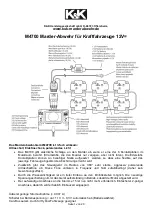
Black plate (78,1)
北
米
Model "A2440BE-B" EDITED: 2007/ 5/ 7
1-52
Seat, seatbelt and SRS airbags
tem is designed to determine the activa-
tion or deactivation condition of the front
passenger
’
s SRS frontal airbag depend-
ing on the total load on the front passen-
ger
’
s seat monitored by the front passen-
ger
’
s occupant detection system weight
sensor. For this reason, only the driver
’
s
SRS frontal airbag may deploy in the
event of a collision, but this does not mean
failure of the system.
If the front sub sensors inside both front
fenders and the impact sensors in the
airbag control module detect a predeter-
mined amount of force during a frontal
collision, the control module sends signals
to the airbag module(s) (only driver
’
s
module or both driver
’
s and front passen-
ger
’
s modules) instructing the module(s)
to inflate the SRS frontal airbag(s). The
driver
’
s and front passenger
’
s SRS frontal
airbags use dual stage inflators. The two
inflators of each airbag are triggered either
sequentially or simultaneously, depending
on the severity of impact in the case of the
driver
’
s SRS frontal airbag and depending
on the severity of impact and the total load
on the seat in the case of the front
passenger
’
s SRS frontal airbag. After
deployment, the SRS airbag immediately
starts to deflate so that the driver
’
s vision
is not obstructed. The time required from
detecting impact to the deflation of the
SRS airbag after deployment is shorter
than the blink of an eye.
Both when only the driver
’
s SRS frontal
airbag deploys and the driver
’
s and front
passenger
’
s SRS frontal airbags deploy,
the driver
’
s and front passenger
’
s seatbelt
pretensioners operate at the same time.
Although it is highly unlikely that the SRS
airbag would activate in a non-accident
situation, should it occur, the SRS airbag
will deflate quickly, not obscuring vision
and will not interfere with the driver
’
s
ability to maintain control of the vehicle.
When the SRS airbag deploys, a sudden,
fairly loud inflation noise will be heard and
some smoke will be released. These
occurrences are a normal result of the
deployment. This smoke does not indicate
a fire in the vehicle.
CAUTION
Do not touch the SRS airbag system
components around the steering
wheel and dashboard with bare
hands right after deployment. Doing
so can cause burns because the
components can be very hot as a
result of deployment.
The driver
’
s SRS frontal airbag and front
passenger
’
s SRS frontal airbag are de-
signed to deploy in the event of an
accident involving a moderate to severe
frontal collision. It is basically not designed
to deploy in lesser frontal impacts be-
cause the necessary protection can be
achieved by the seatbelt alone. Also, they
are basically not designed to deploy in
side or rear impacts or in roll-over acci-
dents because deployment of only the
driver
’
s SRS frontal airbag or both driver
’
s
and front passenger
’
s SRS frontal airbags
would not help the occupant in those
situations. The driver
’
s and front passen-
ger
’
s SRS frontal airbags are designed to
function on a one-time-only basis.
SRS airbag deployment depends on the
level of force experienced in the passen-
ger compartment during a collision. That
level differs from one type of collision to
another, and it may have no bearing on
the visible damage done to the vehicle
itself.
















































